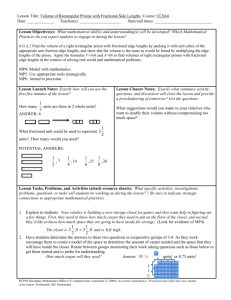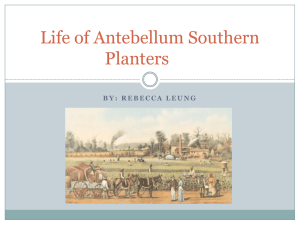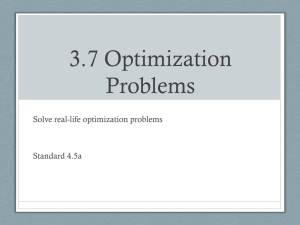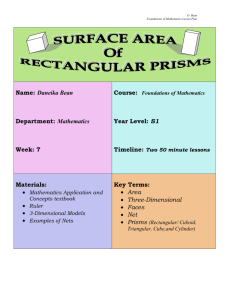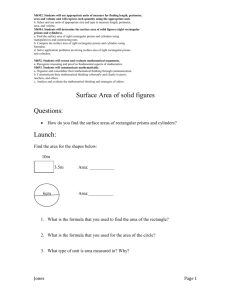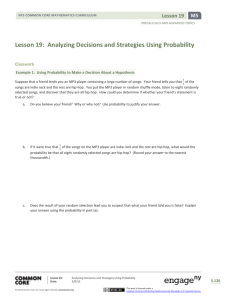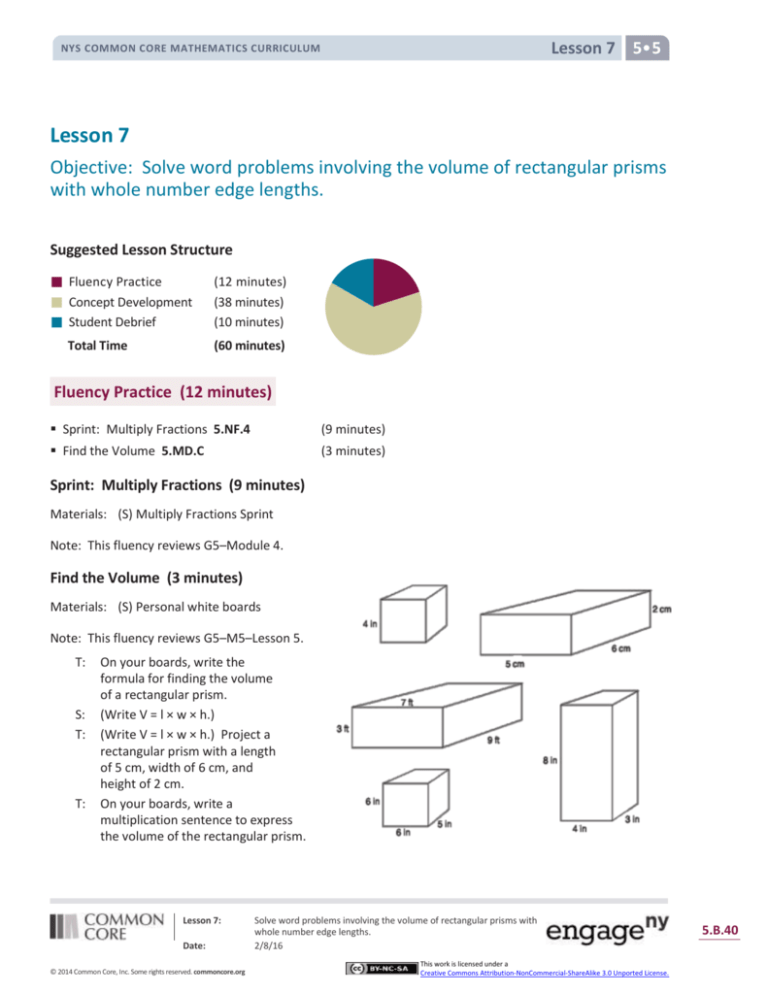
Lesson 7 5•5
NYS COMMON CORE MATHEMATICS CURRICULUM
Lesson 7
Objective: Solve word problems involving the volume of rectangular prisms
with whole number edge lengths.
Suggested Lesson Structure
Fluency Practice
Concept Development
Student Debrief
Total Time
(12 minutes)
(38 minutes)
(10 minutes)
(60 minutes)
Fluency Practice (12 minutes)
Sprint: Multiply Fractions 5.NF.4
(9 minutes)
Find the Volume 5.MD.C
(3 minutes)
Sprint: Multiply Fractions (9 minutes)
Materials: (S) Multiply Fractions Sprint
Note: This fluency reviews G5–Module 4.
Find the Volume (3 minutes)
Materials: (S) Personal white boards
Note: This fluency reviews G5–M5–Lesson 5.
T:
S:
T:
T:
On your boards, write the
formula for finding the volume
of a rectangular prism.
(Write V = l × w × h.)
(Write V = l × w × h.) Project a
rectangular prism with a length
of 5 cm, width of 6 cm, and
height of 2 cm.
On your boards, write a
multiplication sentence to express
the volume of the rectangular prism.
Lesson 7:
Date:
© 2014 Common Core, Inc. Some rights reserved. commoncore.org
Solve word problems involving the volume of rectangular prisms with
whole number edge lengths.
2/8/16
This work is licensed under a
Creative Commons Attribution-NonCommercial-ShareAlike 3.0 Unported License.
5.B.40
Lesson 7 5•5
NYS COMMON CORE MATHEMATICS CURRICULUM
S:
(Beneath V = l × w × h, write V = 5 cm × 6 cm × 2 cm. Beneath it, write V = 60 cm3.)
Continue this process with the other rectangular prisms.
T:
S:
T:
S:
(Project a cube with side lengths equal to 4 inches.) Name the prism.
Cube.
On your boards, write a multiplication sentence to show the volume of the cube.
(Write V = 4 in × 4 in × 4 in. Beneath it, write V = 64 in3.)
Concept Development (38 minutes)
Materials: (S) Problem Set
Note: The time normally allotted for the Application Problem
has been included in the Concept Development portion of
today’s lesson.
Suggested Delivery of Instruction for Solving Lesson 7’s Word
Problems
1. Model the problem.
Have two pairs of students who can successfully model the
problem work at the board while the others work
independently or in pairs at their seats. Review the following
questions before beginning the first problem:
Can you draw something?
What can you draw?
What conclusions can you make from your drawing?
As students work, circulate. Reiterate the questions above.
After two minutes, have the two pairs of students share only
their labeled diagrams. For about one minute, have the
demonstrating students receive and respond to feedback and
questions from their peers.
NOTES ON
MULTIPLE MEANS OF
ENGAGEMENT:
The problems in today’s lesson are
focused on planters and gardening.
The lesson could serve as a
springboard for planning a school
garden. Students could plan planters
as Geoffrey does in the lesson given
parameters of height or base area.
Students might also research optimal
soil depths (and thus volume) for
particular plants and vegetables to
incorporate into their designs.
Bringing their designs into reality is the
ultimate real world problem
connection. If it is possible, let them
try. Writing a proposal to present the
designs (along with estimated costs) to
the principal or school board
encompasses many skills, but even
cardstock planters with paper flowers
can be a rewarding experience.
2. Calculate to solve and write a statement.
Give everyone two minutes to finish work on that question, sharing their work and thinking with a peer. All
should write their equations and statements of the answer.
3. Assess the solution for reasonableness.
Give students one to two minutes to assess and explain the reasonableness of their solution.
Note: Geoffrey builds rectangular planters. All of the inside dimensions of the planters are whole numbers.
Lesson 7:
Date:
© 2014 Common Core, Inc. Some rights reserved. commoncore.org
Solve word problems involving the volume of rectangular prisms with
whole number edge lengths.
2/8/16
This work is licensed under a
Creative Commons Attribution-NonCommercial-ShareAlike 3.0 Unported License.
5.B.41
Lesson 7 5•5
NYS COMMON CORE MATHEMATICS CURRICULUM
Problem 1
Geoffrey’s first planter is 8 feet long and 2 feet wide. The container is filled with soil to a height of 3 feet in
the planter. What is the volume of soil in the planter? Explain your work using a diagram.
In this problem students are given three
dimensions (length, width, and height)
and asked to find the volume of the soil
in the planter. The use of the volume
formula allows students to find the
number of cubic feet of soil in the
planter. A non-scaled illustration of the
planter is the most logical diagram to
accompany this work.
Problem 2
Geoffrey wants to grow some tomatoes in four large planters. He wants each planter to have a volume of
320 cubic feet, but he wants them all to be different. Show four different ways Geoffrey can make these
planters, and draw diagrams with the planters’ measurements on them.
In Problem 2, students are asked to come up with four sets of differing dimensions that will all result in a
volume of 320 cubic feet. This problem requires students to think in terms of whole to part. They will need
to find factors of 32 tens to generate the dimensions. The illustrations are just four such examples.
Encourage students to come up with different values for each dimension rather than just changing the name
of the same dimensions (length, width, and height) repeatedly, although that method would result in the
same volume. Simply changing the shape of the planter can provide opportunities for discussion of which
shape might be best to use for different situations. For example, in a small yard, planting a tree which would
need more depth than length might be the best option. There are a wide variety of dimensions that would be
acceptable here, but be sure to have students check their multiplication using the volume formula.
Lesson 7:
Date:
© 2014 Common Core, Inc. Some rights reserved. commoncore.org
Solve word problems involving the volume of rectangular prisms with
whole number edge lengths.
2/8/16
This work is licensed under a
Creative Commons Attribution-NonCommercial-ShareAlike 3.0 Unported License.
5.B.42
Lesson 7 5•5
NYS COMMON CORE MATHEMATICS CURRICULUM
Problem 3
Geoffrey wants to make one planter that extends from the ground to just below his back window. The
window starts 3 feet off the ground. If he wants the planter to hold 36 cubic feet of soil, name one way he
could build the planter so it is not taller than 3 feet. Explain how you know.
This problem requires students to work backwards and reason
that since Geoffrey needs 36 cubic feet of volume and that the
height of Geoffrey’s planter is 3 feet, then division shows that
the base of the planter must have an area of 12 square feet.
From there, students have the freedom to design a planter with
a base measuring12 ft × 1 ft, 6 ft × 2 ft, or 4 ft × 3 ft. (Note:
These dimensions may represent either the length or the
width.) Again, this presents an opportunity to discuss the
connection between areas of the base and the shape the
planter will take. Extend the problem by asking students to
choose the planter that would not extend beyond a 5-foot
window. (Any of the previously mentioned planters could work
in this case, depending on which side is turned towards the
window.) These discussions are sure to invite construction of
viable arguments and the opportunity to critique the reasoning
of classmates.
NOTES ON
MULTIPLE MEANS OF
EXPRESSION:
If students have difficulty drawing the
rectangular prisms freehand, isometric
dot paper can be used as a scaffold.
Students may also like to use a
computer to draw their figures to be
printed out. Calculations can be done
alongside.
Problem 4
After all of this gardening work, Geoffrey decides he needs a new shed to replace the old one. His current
shed is a rectangular prism that measures 6 feet long by 5 feet wide by 8 feet high. He realizes he needs a
shed with 480 cubic feet of storage.
Lesson 7:
Date:
© 2014 Common Core, Inc. Some rights reserved. commoncore.org
Solve word problems involving the volume of rectangular prisms with
whole number edge lengths.
2/8/16
This work is licensed under a
Creative Commons Attribution-NonCommercial-ShareAlike 3.0 Unported License.
5.B.43
Lesson 7 5•5
NYS COMMON CORE MATHEMATICS CURRICULUM
a. Will he achieve his goal if he doubles each dimension? Why or why not?
This part of Problem 4 gives students a chance to explore the exponential growth potential of doubling all
three dimensions simultaneously. Doubling the length, width, and height of Geoffrey’s shed will result in a
volume that is 8 times that of his current shed (l × 2) × (w × 2) × (h × 2) = (l × w × h) × 8. While this size shed
certainly provides the 480 cubic feet he is looking for, students can reason that doubling each dimension
would lead to a shed that is far larger than Geoffrey needs. This may lead to students trying to double only
two of the dimensions and then realizing that simply doubling one of the dimension of his shed gives Geoffrey
double the volume. This discussion can also include an exploration of which dimension makes the most sense
to double given that this is a garden shed. Would doubling the height give more usable space for gardening
equipment? Does it make more sense to double either the length or the width? Challenge: Is there a way to
change two dimensions and still simply double the space?
b. If he wants to keep the height the same, what could the other dimensions be so that he gets the volume he
wants?
This problem builds on the students’ thinking from the previous problem and asks them to identify
dimensions that would yield a shed volume of 480 cubic feet while maintaining a height of 8 feet. Most
students will correctly reason that you simply need to double one of the other dimensions (the length or the
width) in order to create a doubled volume. However, there are additional ways to create a volume of 480
cubic feet with a height of 8 feet, including halving the length and quadrupling the width. Engage students in
a discussion about why this is possible (think back to Problem 3) and have them share their alternate
solutions.
Lesson 7:
Date:
© 2014 Common Core, Inc. Some rights reserved. commoncore.org
Solve word problems involving the volume of rectangular prisms with
whole number edge lengths.
2/8/16
This work is licensed under a
Creative Commons Attribution-NonCommercial-ShareAlike 3.0 Unported License.
5.B.44
Lesson 7 5•5
NYS COMMON CORE MATHEMATICS CURRICULUM
c. If he uses the dimensions in Part (b), what would be the area of the new shed’s floor?
Part (c) requires students to remember their
work from G5–M5–Lesson 4 and multiply the
length times the width to find the area of the
shed floor. Since students will be using their
varied answers from Part (b) to answer this
question, expect to find variety in responses
here as well. However, this is another
opportunity to engage students in a discussion
about why the area must be 60 square feet,
despite using different dimensions from Part
(b).
Problem Set (10 minutes)
Students should do their personal best to complete the
Problem Set within the allotted 10 minutes. For some
classes, it may be appropriate to modify the assignment by
specifying which problems they work on first. Some
problems do not specify a method for solving. Students
solve these problems using the RDW approach used for
Application Problems.
Student Debrief (10 minutes)
Lesson Objective: Solve word problems involving the
volume of rectangular prisms with whole number edge
lengths.
The Student Debrief is intended to invite reflection and
active processing of the total lesson experience.
Invite students to review their solutions for the Problem
Set. They should check work by comparing answers with a
partner before going over answers as a class. Look for misconceptions or misunderstandings that can be
addressed in the Debrief. Guide students in a conversation to debrief the Problem Set and process the lesson.
You may choose to use any combination of the questions below to lead the discussion.
What effect does doubling one dimension have on the volume? Doubling two dimensions?
Doubling all dimensions? Why?
What effect would doubling one dimension while halving another have on the volume? Why?
How many prisms can you think of that have a volume of 100 cm3?
If Geoffrey had been using fractional lengths for the dimensions for his planters, how would that
have changed the possible answers to these questions?
Lesson 7:
Date:
© 2014 Common Core, Inc. Some rights reserved. commoncore.org
Solve word problems involving the volume of rectangular prisms with
whole number edge lengths.
2/8/16
This work is licensed under a
Creative Commons Attribution-NonCommercial-ShareAlike 3.0 Unported License.
5.B.45
Lesson 7 5•5
NYS COMMON CORE MATHEMATICS CURRICULUM
Exit Ticket (3 minutes)
After the Student Debrief, instruct students to complete
the Exit Ticket. A review of their work will help you assess
the students’ understanding of the concepts that were
presented in the lesson today and plan more effectively
for future lessons. You may read the questions aloud to
the students.
Lesson 7:
Date:
© 2014 Common Core, Inc. Some rights reserved. commoncore.org
Solve word problems involving the volume of rectangular prisms with
whole number edge lengths.
2/8/16
This work is licensed under a
Creative Commons Attribution-NonCommercial-ShareAlike 3.0 Unported License.
5.B.46
NYS COMMON CORE MATHEMATICS CURRICULUM
Lesson 7:
Date:
© 2014 Common Core, Inc. Some rights reserved. commoncore.org
Lesson 7 Sprint 5•5
Solve word problems involving the volume of rectangular prisms with
whole number edge lengths.
2/8/16
This work is licensed under a
Creative Commons Attribution-NonCommercial-ShareAlike 3.0 Unported License.
5.B.47
NYS COMMON CORE MATHEMATICS CURRICULUM
Lesson 7:
Date:
© 2014 Common Core, Inc. Some rights reserved. commoncore.org
Lesson 7 Sprint 5•5
Solve word problems involving the volume of rectangular prisms with
whole number edge lengths.
2/8/16
This work is licensed under a
Creative Commons Attribution-NonCommercial-ShareAlike 3.0 Unported License.
5.B.48
Lesson 7 Problem Set 5•5
NYS COMMON CORE MATHEMATICS CURRICULUM
Name
Date
Geoffrey builds rectangular planters.
1. Geoffrey’s first planter is 8 feet long and 2 feet wide. The container is filled with soil to a height of 3 feet
in the planter. What is the volume of soil in the planter? Explain your work using a diagram.
2. Geoffrey wants to grow some tomatoes in four large planters. He wants each planter to have a volume of
320 cubic feet, but he wants them all to be different. Show four different ways Geoffrey can make these
planters, and draw diagrams with the planters’ measurements on them.
Planter A
Planter B
Planter C
Planter D
Lesson 7:
Date:
© 2014 Common Core, Inc. Some rights reserved. commoncore.org
Solve word problems involving the volume of rectangular prisms with
whole number edge lengths.
2/8/16
This work is licensed under a
Creative Commons Attribution-NonCommercial-ShareAlike 3.0 Unported License.
5.B.49
NYS COMMON CORE MATHEMATICS CURRICULUM
Lesson 7 Problem Set 5•5
3. Geoffrey wants to make one planter that extends from the ground to just below his back window. The
window starts 3 feet off the ground. If he wants the planter to hold 36 cubic feet of soil, name one way
he could build the planter so it is not taller than 3 feet. Explain how you know.
4. After all of this gardening work, Geoffrey decides he needs a new shed to replace the old one. His current
shed is a rectangular prism that measures 6 feet long by 5 feet wide by 8 feet high. He realizes he needs a
shed with 480 cubic feet of storage.
a. Will he achieve his goal if he doubles each dimension? Why or why not?
b. If he wants to keep the height the same, what could the other dimensions be for him to get the
volume he wants?
c. If he uses the dimensions in Part (b), what could be the area of the new shed’s floor?
Lesson 7:
Date:
© 2014 Common Core, Inc. Some rights reserved. commoncore.org
Solve word problems involving the volume of rectangular prisms with
whole number edge lengths.
2/8/16
This work is licensed under a
Creative Commons Attribution-NonCommercial-ShareAlike 3.0 Unported License.
5.B.50
NYS COMMON CORE MATHEMATICS CURRICULUM
Name
Lesson 7 Exit Ticket 5•5
Date
1. A storage shed is a rectangular prism and has dimensions of 6 meters by 5 meters by 12 meters. If Jean
were to double these dimensions, she believes she would only double the volume. Is she correct?
Explain why or why not. Include a drawing in your explanation.
Lesson 7:
Date:
© 2014 Common Core, Inc. Some rights reserved. commoncore.org
Solve word problems involving the volume of rectangular prisms with
whole number edge lengths.
2/8/16
This work is licensed under a
Creative Commons Attribution-NonCommercial-ShareAlike 3.0 Unported License.
5.B.51
Lesson 7 Homework 5•5
NYS COMMON CORE MATHEMATICS CURRICULUM
Name
Date
Wren makes some rectangular display boxes.
1. Wren’s first display box is 6 inches long, 9 inches wide, and 4 inches high. What is the volume of the
display box? Explain your work using a diagram.
2. Wren wants to put some artwork into three large display boxes. She knows they all need a volume of 60
cubic inches, but she wants them all to be different. Show three different ways Wren can make these
boxes by drawing diagrams and labeling the measurements.
Shadow Box A
Shadow Box B
Shadow Box C
Lesson 7:
Date:
© 2014 Common Core, Inc. Some rights reserved. commoncore.org
Solve word problems involving the volume of rectangular prisms with
whole number edge lengths.
2/8/16
This work is licensed under a
Creative Commons Attribution-NonCommercial-ShareAlike 3.0 Unported License.
5.B.52
Lesson 7 Homework 5•5
NYS COMMON CORE MATHEMATICS CURRICULUM
3. Wren wants to build a box to organize her scrapbook supplies. She has a stencil set that is 12 inches wide
that needs to lay flat in the bottom of the box. The supply box must also be no taller than 2 feet. Name
one way she could build a toy box with a volume of 72 cubic inches.
4. After all of this organizing, Wren decides she also needs more storage for her soccer equipment. Her
current storage box measures 1 foot long by 2 feet wide by 2 feet high. She realizes she needs to replace
it with a box with 12 cubic feet of storage, so she doubles the width.
a. Will she achieve her goal if she does this? Why or why not?
b. If she wants to keep the height the same, what could the other dimensions be for a 12-cubic-foot
storage box?
c. If she uses the dimensions in Part (b), what is the area of the new storage box’s floor?
d. How has the area of the bottom in her new storage box changed? Explain how you know.
Lesson 7:
Date:
© 2014 Common Core, Inc. Some rights reserved. commoncore.org
Solve word problems involving the volume of rectangular prisms with
whole number edge lengths.
2/8/16
This work is licensed under a
Creative Commons Attribution-NonCommercial-ShareAlike 3.0 Unported License.
5.B.53


